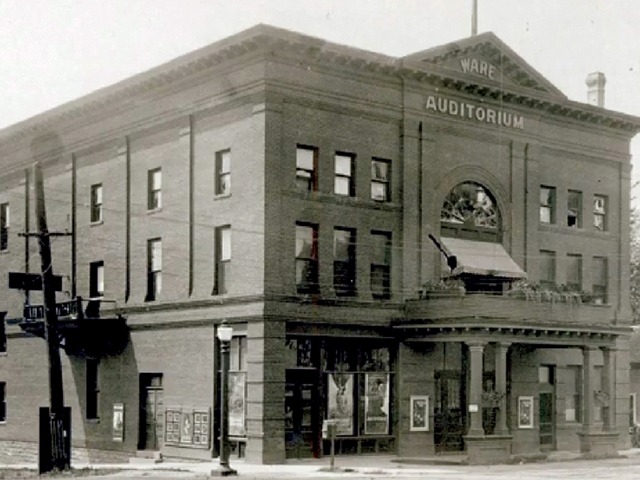 “Masquerade Ball! Easter Monday, April 7, 1890, at the Opera House. Tickets $1, gallery 50¢ with the privilege of dancing after 11 o’clock. Everybody invited. H.T. Budd.”
“Masquerade Ball! Easter Monday, April 7, 1890, at the Opera House. Tickets $1, gallery 50¢ with the privilege of dancing after 11 o’clock. Everybody invited. H.T. Budd.”
So read an ad in the Northfield News as H. Talford (“Tal”) Budd extended an invitation to his second annual ball. But sponsoring entertainment events was not his primary gig. On April 15, 1878, Budd had opened a barbershop on West Third Street and he spent the next 62 years there, attending to Northfield’s tonsorial needs. Budd even made it into the cartoon feature called “Ripley’s Believe It or Not” as the world’s oldest active barber, having practiced his profession 70 continuous years until his death on Oct. 14, 1940. The most he ever charged for a haircut was 85 cents. Budd said that was “as high a sum as any barber should extract at any time.”
April at the turn of the century brought varied entertainment to Northfield, along with misfortune. On April 5, 1900, a touring company presented “A Yenuine Yentleman” about a young immigrant Swede, Sven Hanson, at the new Ware Auditorium (now the Grand Event Center).
Two days later, Ibsen’s A Doll’s House hit the same stage. The reviewer noted that this “intensely Scandinavian play” does not appeal to “Anglican or American natures, especially those who come to the theater to be amused and insist that the play have a happy denouement,” but the play was “greatly pleasing to those who join in the Ibsen cult.”
Within a week of this performance, a fire broke out in the basement of the Ware which wrecked the interior. The paper reported that “the building presented a sorry sight to the crowds of spectators who gathered.” Musical performances continued throughout the month in other venues. After attending one evening recital, Mr. and Mrs. F.J. Wilcox were run down by a bicycle rider in Central

Park, with Mr. Wilcox sustaining a black eye and Mrs. Wilcox being confined to bed for a time from the severe bruises and the “nervous shock” the accident caused her. The Northfield News opined that “we have in Northfield too much of reckless bicycle riding…It should be the duty of those who ride wheels to look out for those who walk.”
In April of 1917 The Grand temporarily became the sole movie house in Northfield when Fred Boll sold the Gem Theater, located on the west side. “The sale of the Gem removes from Northfield business circles a picturesque figure,” noted the Northfield News. Picturesque indeed. Everett Dilley, long-time manager of The Grand, recalled that the Gem established restrictive codes of admission for its movies: no St. Olaf students and no Carleton women students were allowed to go there, “although sometimes you could see 60 young women lined up at the side door waiting to sneak in.” A flyer (now in the St. Olaf archives) urged a boycott of the Gem, saying that Boll “doggishly cusses the Norwegian race.” The boycott would “demonstrate our Norwegian unity and our respect for our race.”
April of 1932 was a particularly melodious month in Northfield. On April 12, the Minneapolis Symphony, under its popular new conductor Eugene Ormandy, played to a full and enthusiastic house of 2000 at the St. Olaf College gymnasium. The next day the St. Olaf Choir, conducted by F. Melius Christiansen, sang at Skinner Memorial Chapel at Carleton. A week later, on April 20, the Carleton Symphony band under Jimmy Gillette returned the favor with a concert at the St. Olaf gym, playing Christiansen’s Norwegian Rhapsody No. 1, as well as Gillette’s own Pagan Symphony. The Northfield News commented on the “spirit of friendliness” and “cordial relations” of the two colleges evidenced at the concerts.
The Longfellow School Auditorium was the site of a Cub and Boy Scout show on April 16, 1955, which featured Indian dancing and a re-enactment of the 1876 bank raid by the James-Younger Gang. Three hundred boys participated. Scouts from several troops donned makeup and mohair wigs and wore costumes “authentically patterned after the Sioux sunburst dance regalia.” They were billed as the Wahkonda Great White Indian Dancers.
In past Aprils, Northfielders have enjoyed dressing up as others for entertainment, whether at masquerade balls arranged by a barber in the 1890s or at Scout shows in the 1950s. But of course nothing can compare to our Septembers when the James-Younger Gang rides again (and again) in Northfield.
Information for this story was found in the archives of the Northfield Historical Society.






